The world of dairy production is not limited to large-scale operations. For those passionate about sustainable farming and high-quality dairy products, setting up a micro dairy can be a rewarding endeavor.
In this comprehensive guide, we will delve into the industry, discuss what it takes to get started, explore the best breeds for cows and goats, highlight various specialties for micro dairies, provide insights into costs, and offer tips on branding and marketing. We’ll also showcase some real micro dairy producers who have made a mark in the industry.
The Micro Dairy Industry
The micro dairy industry has gained momentum in recent years, driven by consumer demand for locally sourced, artisanal dairy products. Micro dairies typically focus on small-scale production, allowing for more hands-on care of the animals and attention to the quality of the final products. These dairies often prioritize sustainable and ethical practices, connecting consumers with the origin of their dairy products.
Getting Started: What You Need & What To Know
Starting a micro dairy on your property as a homesteader, hobby farmer, or small farmer can be an exciting and rewarding venture. However, there are several key considerations and requirements to keep in mind to ensure a successful and sustainable operation. Here’s a quick overview of what you’ll need to get started:
Research and Planning: Begin by conducting thorough research on dairy farming practices, local regulations, and market demand for dairy products in your area. Understand the specific requirements for establishing a micro dairy and the necessary permits or licenses you may need.
Adequate Space and Facilities: Evaluate your property to ensure you have enough space to accommodate your dairy operation. You’ll need a dedicated area for the cows, including grazing land and a shelter or barn for housing them. Additionally, you’ll require milking parlors or a milking station, storage facilities for milk, and a processing area if you plan to process the milk on-site.
Suitable Breeds: Choose a dairy cattle breed that suits your specific goals and the local climate. Popular breeds for small-scale dairy farming include Jerseys, Guernseys, and Brown Swiss. Consider acquiring young heifers and raising them on your property, or purchasing mature cows from reputable sources. Aim to have a small herd size initially, perhaps 2 to 5 cows, as this is more manageable for beginners. For goats, you’ll likely want to stick to either the Alpine or Nubian breeds.
Feed and Nutrition: Develop a feeding plan that meets the nutritional requirements of your cattle. Pasture grazing should be a significant component, supplemented with hay, silage, and possibly grain-based feeds. Consult with a local veterinarian or an experienced dairy farmer to ensure your feeding regimen is well-balanced and supports optimal milk production.
Milking Equipment: Invest in suitable milking equipment, including a milking machine or hand-operated milking devices. Ensure that all equipment is clean, well-maintained, and in compliance with hygiene standards. You may also need milk cooling and storage equipment, such as bulk milk tanks or smaller refrigeration units.

Double Milking Machine for Cows
A good example of a possible milking machine you may choose, this one (Dakoa does not recommend any particular brand or model) retails for around $2,000.
- Milk Handling and Processing: Decide whether you want to sell raw milk or process it into value-added products such as cheese, yogurt, or butter. If you plan to process milk, you’ll need appropriate equipment and facilities, including pasteurization equipment, cheese vats, and packaging materials. Ensure you comply with local health and safety regulations regarding milk handling and processing.
- Marketing and Distribution: Identify your target market and develop a marketing strategy to reach potential customers. This could include selling directly to consumers through on-farm sales, farmers markets, or establishing relationships with local stores, cafés, and restaurants. Consider creating a brand and promoting your products through online platforms and social media as well.
- Financial Planning: Prepare a comprehensive business plan that outlines your goals, projected expenses, and potential revenue streams. Consider startup costs, ongoing operational expenses, and any loans or grants that may be available for small-scale agricultural ventures. Ensure you have a clear understanding of the financial viability of your micro dairy before committing significant resources.
- Knowledge and Skills: Acquire the necessary knowledge and skills to manage a dairy operation successfully. Attend workshops, training programs, or seek mentorship from experienced dairy farmers to learn about best practices in cattle management, milk production, and dairy processing.
- Compliance and Regulations: Familiarize yourself with local regulations, licensing requirements, and health and safety standards related to dairy farming and milk processing. Ensure that you adhere to these regulations to maintain a legal and reputable operation.
Remember, starting a micro dairy requires hard work, dedication, and a commitment to animal welfare and sustainable practices. Continuously educate yourself, adapt to market demands, and seek support from the farming community to enhance your chances of success.
Best Breeds for Cows
Here’s an overview of the popular dairy cattle breeds for small-scale farming, including Jerseys, Guernseys, and Brown Swiss, and their characteristics in terms of milk production, output, meat, care, temperament, and size:
Jerseys
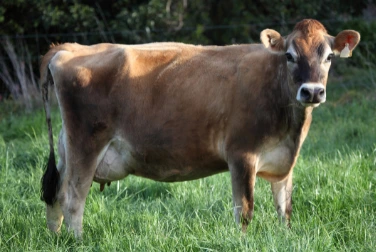
Known for their rich, creamy milk with high butterfat and protein content, Jersey cows are popular among micro dairy producers. They are docile, efficient grazers, and adapt well to various climates.
- Milk Production: Jerseys are known for their high butterfat content, making their milk ideal for producing rich and flavorful dairy products such as cheese, butter, and ice cream. While they have a smaller frame compared to other breeds, Jerseys are efficient milk producers.
- Milk Output: Jerseys produce a moderate amount of milk per day, typically ranging from 4 to 6 gallons.
- Meat: Jerseys are not primarily bred for meat production, as their focus is on milk production. However, their calves can be raised for beef if desired.
- Care: Jerseys are generally hardy and adaptable to various climates. They require adequate grazing pasture, good quality hay, and proper nutrition to maintain their milk production.
- Temperament: Jerseys are known for their docile and friendly nature, making them easier to handle and work with, especially for small-scale operations.
- Size: Jerseys are a smaller breed, with cows weighing between 900 and 1,200 pounds (410 to 540 kg) and standing about 4 to 4.5 feet tall at the shoulder.
Guernseys
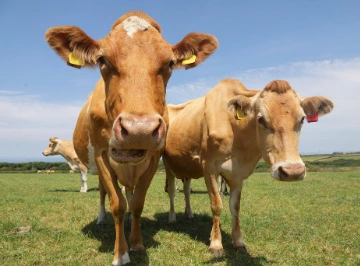
Guernsey cows produce milk with a golden hue due to the high beta-carotene content in their diet. They are renowned for their gentle nature and ability to thrive on pasture-based systems.
- Milk Production: Guernseys are recognized for their milk’s golden color and high butterfat content, which produces rich and creamy dairy products. They have good milk production capabilities and are efficient converters of feed into milk.
- Milk Output: Guernseys produce a moderate to high amount of milk, averaging around 6 to 8 gallons per day.
- Meat: Like Jerseys, Guernseys are not primarily raised for meat production, but their calves can be used for beef.
- Care: Guernseys require proper nutrition and a well-balanced diet to maintain their milk production. They are adaptable to different climates and can thrive on pasture-based feeding systems.
- Temperament: Guernseys are generally known for their calm temperament, making them easy to handle and work with.
- Size: Guernseys are medium-sized cows, with adult females weighing between 1,000 to 1,400 pounds (450 to 635 kg) and standing about 4.5 to 5 feet tall at the shoulder.
Brown Swiss
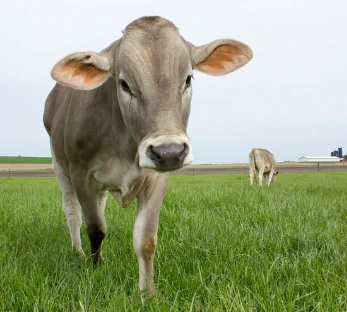
Highly valued for exceptional milk production and longevity, Brown Swiss cows offer a well-balanced milk composition suitable for various dairy products. Their hardiness, adaptability to different climates, and calm temperament make them popular among small-scale dairy farmers.
- Milk Production: Brown Swiss cows are renowned for their exceptional milk production and longevity. Their milk has a good balance of butterfat and protein content, making it suitable for a wide range of dairy products.
- Milk Output: Brown Swiss cows produce a relatively high volume of milk, typically ranging from 6 to 10 gallons per day.
Meat: While Brown Swiss are primarily known for milk production, their calves can be raised for beef. They have good meat quality. - Care: Brown Swiss cattle are known for their hardiness and adaptability to various environmental conditions. They are generally low-maintenance and have a good feed conversion efficiency.
- Temperament: Brown Swiss cows are usually calm and gentle, although individual temperaments can vary. They are generally easy to handle and work with.
- Size: Brown Swiss cows are larger compared to Jerseys and Guernseys. Females can weigh between 1,200 to 1,800 pounds (540 to 820 kg) and stand about 4.5 to 5.5 feet tall at the shoulder.
Each of these breeds has its unique strengths, and the choice depends on your specific goals, preferences, and the characteristics that align with your farm’s needs. Be sure to consider factors such as milk production, temperament, care requirements, and the overall suitability to your local climate and farming conditions when selecting a breed for your small-scale dairy operation. The right breed can make a huge difference!
Best Breeds for Goats
Don’t automatically assume your boutique dairy farm must be cattle-based. Why not tap into a growing niche and choose to focus on goats instead?
Here’s an overview of two popular goat breeds for small-scale dairy farming, including Alpine and Nubian goats, and their characteristics in terms of milk production, output, meat, care, temperament, and size:
Alpine Goats
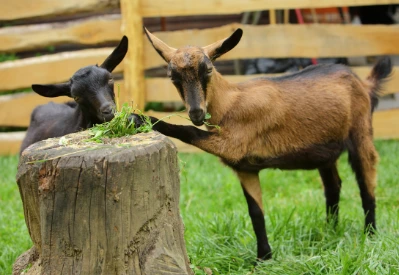
Alpine goats are hardy and versatile, thriving in various environments. They produce a good amount of milk with medium butterfat content and are suitable for both dairy and meat purposes.
- Milk Production: Alpine goats are known for their excellent milk production. They produce a good quantity of milk with a moderate to high butterfat content, making their milk suitable for various dairy products.
- Milk Output: Alpine goats can produce around 1 to 2 gallons of milk per day, depending on factors such as genetics, nutrition, and lactation stage.
- Meat: While Alpine goats are primarily raised for milk production, their offspring can be used for meat production. They have decent meat quality.
- Care: Alpine goats are hardy and adaptable to different climates. They require a well-balanced diet with adequate pasture grazing, hay, and supplemental feed to maintain their milk production.
- Temperament: Alpine goats are generally known for their friendly and easygoing nature. They are social animals and can be quite docile, making them manageable and suitable for small-scale operations.
- Size: Alpine goats are of medium size, with females weighing between 135 and 155 pounds (61 to 70 kg) and standing about 30 to 32 inches tall at the shoulder.
Nubian Goats
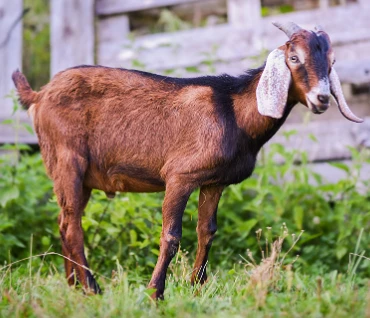
Nubian goats are prized for their high milk production and sweet, flavorful milk. They are known for their distinctive long ears and adaptability to different climates.
- Milk Production: Nubian goats are popular for their high milk production and rich, creamy milk. They have a high butterfat content, making their milk desirable for making cheese, butter, and other dairy products.
- Milk Output: Nubian goats can produce around 1.5 to 3 gallons of milk per day, depending on various factors such as genetics, nutrition, and lactation stage.
- Meat: While Nubian goats are primarily bred for milk production, their offspring can also be used for meat production. They have good meat quality.
- Care: Nubian goats have specific nutritional requirements and need a well-balanced diet, including good quality forage and proper supplementation. They can adapt to different climates, but are more susceptible to extreme heat compared to other breeds.
- Temperament: Nubian goats are known for their friendly and outgoing personalities. They can be quite vocal and assertive compared to other breeds, but are generally affectionate and social.
- Size: Nubian goats are relatively large in size compared to some other breeds. Does typically weigh between 135 and 175 pounds (61 to 79 kg) and stand about 30 to 32 inches tall at the shoulder.
Specialties for Micro Dairies: Create That Boutique Farm-to-Hand Experience
Creamery
A micro dairy creamery offers a unique opportunity to produce artisanal butters, creams, and cultured dairy products like yogurt and sour cream.
With small-scale production, micro dairies can focus on crafting these products in small batches, allowing for meticulous attention to detail and the creation of distinctive flavors and textures.
By using their own high-quality milk, micro dairies can ensure the exceptional taste and quality of their creamery products, appealing to discerning customers who value small-batch, locally sourced dairy.
Cheese Production

Micro dairies specializing in cheese production can delight in crafting handcrafted cheeses that cater to diverse tastes.
From classic varieties like cheddar, gouda, and feta to delicate soft cheeses like camembert, micro dairies can experiment with different recipes, aging techniques, and flavor profiles.
Small-scale production allows for closer monitoring and care during the cheese-making process, resulting in unique and flavorful cheeses that stand out in the market.
Micro dairies can also leverage their flexibility to create limited edition or seasonal cheeses, attracting cheese enthusiasts seeking exceptional and distinctive offerings.
Ice Cream
Micro dairies can create delectable, small-batch ice cream that showcases the richness and quality of their own high-grade milk.
With the ability to control every step of the production process, micro dairies can craft ice cream with superior taste and texture.
They have the freedom to experiment with a wide range of flavors, incorporating locally sourced, seasonal ingredients to create unique and exciting taste experiences.
Moreover, micro dairies can cater to niche dietary preferences by offering specialized options such as vegan or lactose-free ice creams, expanding their customer base and meeting the needs of a diverse consumer market.
By specializing in these areas, micro dairies can differentiate themselves from larger-scale operations and offer consumers a truly distinctive and high-quality dairy experience. They can showcase their craftsmanship, creativity, and commitment to producing exceptional dairy products that capture the essence of local and artisanal production.
Cost Considerations
Starting a micro dairy isn’t cheap, but there are resources like grants you can apply for as well as small business agricultural loans. Make sure you have enough financing when you first start up to cover your micro enterprise for at least a year, just in case.
Here are a few things you’ll need to consider and budget for moving forward:
Animals
The cost of acquiring cows or goats can vary depending on factors such as breed, age, and quality. Prices may range from a few hundred to several thousand dollars per animal. It’s important to research different breeds and their market prices to find animals that align with your budget and desired production goals.
Also, make sure to consider the ongoing costs of maintaining the health and well-being of the animals, such as veterinary care, vaccinations, and deworming.
Infrastructure
Building suitable housing, milking parlors, fencing, and purchasing milking equipment are crucial investments for a micro dairy. The infrastructure costs can vary widely depending on factors such as the size of the operation, the complexity of the facilities, and the availability of existing structures.
It’s highly recommended to consult with experts or experienced farmers to determine the appropriate infrastructure requirements and estimate the associated costs. Investing in quality infrastructure is essential for ensuring animal welfare, milk quality, and operational efficiency.
Feed and Supplies
Micro dairies need to budget for animal feed, supplements, bedding, and general supplies. The cost of feed can vary based on factors such as the type of forage available, the nutritional requirements of the animals, and the local market prices.
Proper nutrition is crucial for the health and productivity of the animals, so it’s important to allocate sufficient funds for high-quality feed. Don’t forget other supplies like cleaning agents, milking supplies, and bedding materials, as they are essential for maintaining a clean and hygienic environment.
Labor
Labor costs should also be taken into account when establishing a micro dairy. While small-scale operations may not require extensive labor, it is important to consider the time and effort involved in daily milking, feeding, animal care, and general farm maintenance.
If additional help is needed, budgeting for hired labor or considering partnerships or cooperative models can be beneficial.
Assessing the labor requirements and associated costs will help determine the feasibility and sustainability of the micro dairy venture.
Marketing and Licensing
Micro dairies should allocate resources for marketing efforts, such as branding, packaging, and promotional activities.
Developing a strong brand and establishing relationships with local markets, restaurants, and retail outlets can help create a customer base for the dairy products.
Additionally, ensure compliance with relevant licensing, permits, and regulations governing dairy production in your region.
Research the costs associated with obtaining necessary licenses and certifications to ensure legal compliance and product quality assurance.
Profitability and Pricing
It’s essential to consider the profitability of the micro dairy business and establish appropriate pricing for the dairy products.
Conduct a thorough analysis of the production costs, including feed, labor, infrastructure, and other overhead expenses, to determine the break-even point and potential profit margins.
Research local market prices for comparable products and factor in the uniqueness and quality of your offerings when setting prices. Regularly review and adjust pricing based on market demand, input costs, and profitability goals to ensure the financial sustainability of the micro dairy.
By carefully considering these cost factors and conducting thorough research and financial planning, aspiring micro dairy farmers can make informed decisions and establish a viable and sustainable operation.
Branding & Marketing Your Boutique Dairy
Crafting a unique and compelling brand for your small-scale boutique dairy farm is essential for attracting customers and standing out in the market.
Here are some valuable strategies and best practices to help you earn success before your competitors:
Use Your Unique Story
Develop a brand story that resonates with consumers and showcases what sets your micro dairy apart. Highlight elements such as sustainable practices, animal welfare, or your connection to the local community.
Share your journey, values, and the passion that drives your dairy farm. Consumers appreciate transparency and enjoy knowing the story behind their dairy products.
Highlight Your Product Quality
Place a strong emphasis on the exceptional quality of your dairy products. Highlight the benefits of small-scale production, where meticulous attention to detail ensures superior taste and freshness.
Emphasize the use of locally sourced, high-quality ingredients and traditional production methods. Consider obtaining certifications or labels that validate the quality and authenticity of your products, as this can build trust among consumers.
Develop Local Partnerships
Forge partnerships with local restaurants, cafés, farmers’ markets, and specialty food stores to showcase and sell your dairy products.
Collaborate with chefs and culinary professionals who value locally sourced, artisanal ingredients. Participate in community events, food festivals, and tastings to build brand awareness and establish personal connections with potential customers.
Consider offering special promotions or exclusive products for your local partners to incentivize collaboration and increase brand exposure.
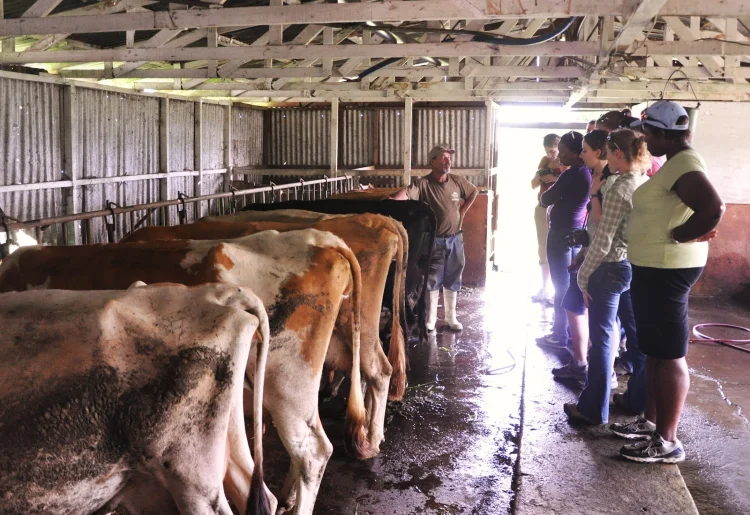
Lean Into Educational Initiatives
Educate consumers about the benefits of small-scale dairy farming and the value of supporting local, sustainable agriculture.
Organize farm tours, workshops, or educational events where visitors can learn about the milking process, animal care, or cheese-making. Offer educational resources on your website, such as blog posts, videos, or recipes, to enhance customer engagement and foster a sense of connection with your brand.
Stand Out With Packaging and Design
Invest in eye-catching and professional packaging that reflects the unique character of your brand. Use high-quality materials and consider eco-friendly options to align with sustainability values.
The design should be visually appealing, showcasing your brand identity and evoking the desired emotions in consumers. Clear labeling that highlights key product attributes, such as the breed of the animals or the nutritional benefits of the milk, can also add value and differentiate your products.
Develop a Strong Online Presence
Establish a strong online presence to reach a broader audience and engage with potential customers. Create a user-friendly website that showcases your brand story, product range, and any certifications or awards.
Utilize social media platforms to share behind-the-scenes glimpses of your farm, introduce your team, and post engaging content related to dairy production and local food culture.
Interact with your audience, respond to inquiries, and encourage customer reviews and testimonials to build trust and credibility.
Get Great at Customer Engagement
Foster strong relationships with your customers by offering exceptional customer service and creating opportunities for feedback and dialogue.
Respond promptly to inquiries, address concerns, and express gratitude for their support. Consider loyalty programs, exclusive events, or newsletters to reward customer loyalty and keep them informed about new product offerings or upcoming farm activities.
Building a brand for your small-scale boutique dairy farm requires consistent effort, creativity, and a deep understanding of your target market.
By focusing on your unique story, product quality, local partnerships, and customer engagement, you can create a strong brand identity that resonates with consumers and establishes your micro dairy as a trusted and sought-after source of premium dairy products.
Finding Inspiration With Real Success Stories
Sweet Grass Dairy
Sweet Grass Dairy, in Thomasville, Georgia, is known for its award-winning artisanal cheeses made from the milk of their grass-fed Jersey cows that happily meander throughout the property. They prioritize sustainable farming practices and have gained recognition for their commitment to quality.

Stroud Micro Dairy
Stroud Micro Dairy is a co-op small dairy farm located in Stroud, UK that produces raw milk, yogurt, and raw milk kefir. With a commitment to regenerative farming and soil health, Stroud focuses on the well-being of their animals, people, and nature. Due to economic realities in the UK, Stroud is presently shut down until next year.
More To Discover
- Why Other Cultures Prefer to Raise Goats for Milk and Meat Instead of Cattle
- SEAD’s Sustainable Seed Pods from Seafood Waste For Eco-Friendly Gardening
- Raise Guinea Fowl in Your Backyard for Lean, Dark Meat & Healthy Eggs Year Round
- Farming Specialty Vegetables: Cultivating Exquisite Flavors and Nurturing Market Niches
Conclusion
Setting up a micro dairy offers the opportunity to create high-quality, artisanal dairy products while promoting sustainability and local connections.
By selecting the best breeds, focusing on unique specialties, and employing effective branding and marketing strategies, micro dairy producers can carve out a niche in the dairy industry.
Inspired by real micro dairy pioneers, aspiring micro dairy owners can embark on a fulfilling journey of creating exceptional dairy products that delight consumers and support sustainable farming practices.





















